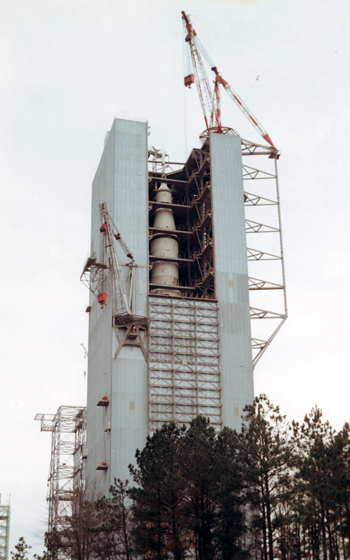
NASA
A component of the George C. Marshall Space Flight Center in Huntsville, Alabama, the Saturn V Dynamic Test Stand represents the last step in the testing process before the vehicle was accepted for full flight status. Built in 1964 to conduct mechanical and vibrational tests on the fully assembled Saturn V Space Vehicle, and measuring 360 feet high and 122 feet by 98 feet at the base, this facility performed crucial ground testing to ensure the success of the Saturn V. Once launched, a Saturn V could not be recovered for testing; therefore, major problems capable of causing failure of the vehicle were discovered and corrected at the Saturn V Dynamic Test Stand before the rocket ever reached the launch complex at the Kennedy Space Center . Any flaw in the vehicle could result in the loss of the lives of the astronauts riding in the Apollo Command Module.
Each component of the rocket was tested separately and in partial and full assembly. Then, the rocket was brought to the Saturn V Dynamic Test Stand to test the entire vehicle under dynamic load conditions. Mechanical and vibrational tests were conducted until the Saturn V vehicle was deemed ready for flight. As a result of the tests performed at the Saturn V Dynamic Test Stand no Saturn V ever failed in flight. After completion of testing for the Saturn V program the Saturn V Dynamic Test Stand was modified for testing the Space Shuttle. At the present time this facility is on a standby basis, but it will be retained for future use in NASA programs because of its unique capabilities to dynamically test large space vehicles.
Visit the National Park Service Travel American Aviation to learn more about Aviation related Historic Sites.
Last updated: August 28, 2017
